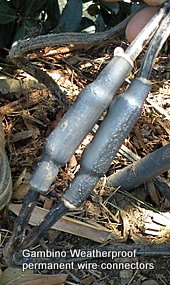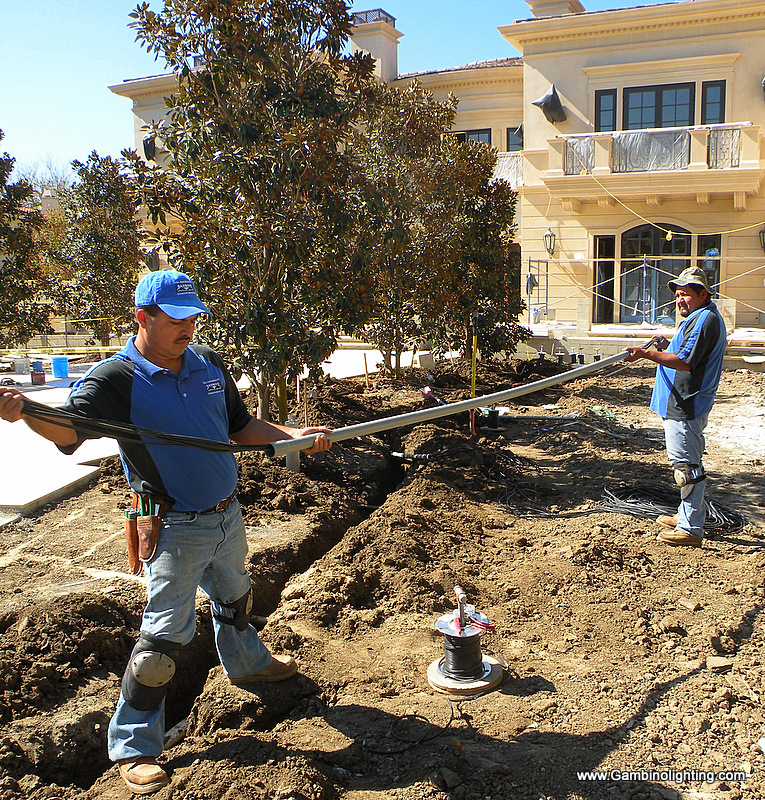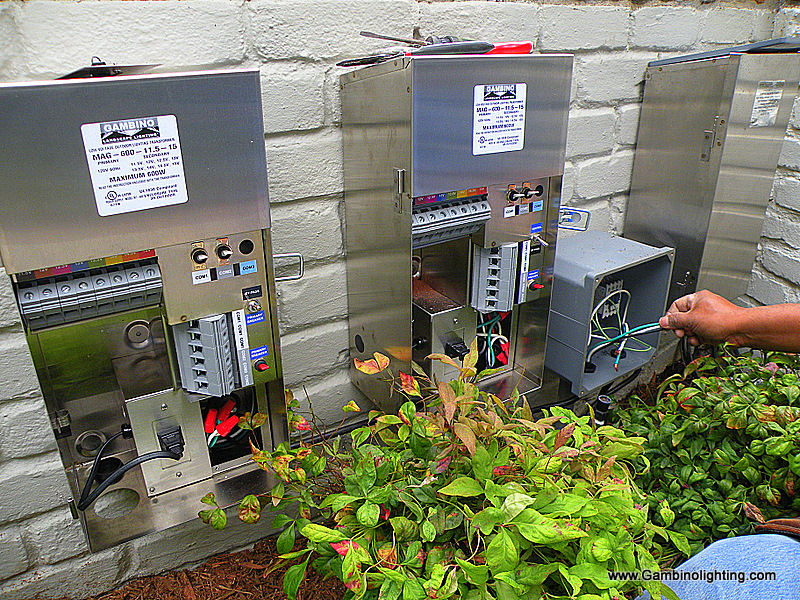27 Jul The High Performance Gambino Landscape Lighting system; 5 Part Recipe for Success!
By Mike Gambino
The five parts of a beautiful high performance landscape lighting system are the foundations of a Gambino landscape lighting system. Not only are the five elements the cornerstone of energy efficient system, understanding how and why they go together is the basis for successful lighting.
(1) Cable & Conduit:
Historically, landscape lighting systems are built with low voltage cable direct buried in a shallow trench or even laid on the ground and covered with mulch presumably to reduce labor and material costs. However, when corners are cut (as is true with all the components of an energy efficient high performance landscape lighting system), this only leads to future problems and with a slogan like “designed and built to last” that is the last thing we want here at Gambino landscape lighting. Future problems that are foreseeable and preventable. Therefore we install all electrical power cable inside rigid PVC electrical conduit and bury it to a 6” depth wherever possible.
Cable left unprotected and not inside rigid electrical conduit is susceptible to being cut or damaged. The kind of minor damage to cable that doesn’t take out a string of lights and goes unnoticed over a long period of time is much worse than one clean cut that shuts down several fixtures. This is so because the damaged cable will draw moisture into it get under the jacket and travel throughout the cable. It can even get into the transformer effectively oxidizing copper strands which cut down on the transmission of power which in turn results in making your lights dimmer and dimmer until they finally shut down. The process is usually slow, effects system performance and enjoy ability and usually goes unnoticed and results in having to replace the whole cable line instead of just repairing one damaged part of it. Installing power cable inside electrical conduit is a vital part of lowering system maintenance.
Electrical conduit proves important to the systems durability, plus it keeps the cable under the ground keeping it from becoming unsightly.
(2 & 3) Fixtures & Lamps (bulbs):
 The fixtures and lamps you put in a landscape lighting system are also vital to its overall performance and function. Besides greatly adding to the pleasure of having a landscape lighting system, Fixtures and lamps have a symbiotic relationship that when kept in balance, are part of the beautiful lighting scheme. Fixtures house the light source, their design and configuration will greatly influence the way you view the lighting. A compromise must be struck between a fixtures ability to conceal the lamp source from view (glare) and its ability not to impede the light spread or negatively affect its intended characteristics or effect. Lenses should be tempered glass so they won’t easily break, must be easily accessible and cleanable as they will need servicing on a regular basis.
The fixtures and lamps you put in a landscape lighting system are also vital to its overall performance and function. Besides greatly adding to the pleasure of having a landscape lighting system, Fixtures and lamps have a symbiotic relationship that when kept in balance, are part of the beautiful lighting scheme. Fixtures house the light source, their design and configuration will greatly influence the way you view the lighting. A compromise must be struck between a fixtures ability to conceal the lamp source from view (glare) and its ability not to impede the light spread or negatively affect its intended characteristics or effect. Lenses should be tempered glass so they won’t easily break, must be easily accessible and cleanable as they will need servicing on a regular basis.
The fixture must be stable and be able to hold its adjustment properly which will contribute to the lower maintenance of the lighting system. In addition it also must keep the lamp completely dry from moisture and wetness that is inherently present and in abundance in the garden. Today’s lamps must stay dry, must be kept from becoming too hot and overheating. Excess heat will damage the electronics contained within which means the fixture must also have proper heat sinking and venting capability.
The light source most commonly used today is the LED or light emitting diode. Color of the light must be flattering to all that it illuminates. It must be soft enough to avoid hotspots yet powerful enough to illuminate at long distances up to 100 feet away like at the top of a majestic tree. As previously stated the fixture needs proper heat sinking but so does the LED module itself.
A lighting system that contains LED’s not specifically designed to work in its fixture is a system that is going to be high maintenance and a pain for the owner.
Light sources are not just there: they obviously play a critically important role in the high performance low voltage landscape lighting system.
(4) Weatherproof connections:
 Weatherproof connectors play a vital and necessary role in any efficient lighting system. A sound mechanical connecting device is necessary to keep wire splices tight and conductors isolated to avoid dead shorting and possible overloads of the system. Brass lugs with locking screws and marine grade heat shrink with special impregnated silicone insulated inner walls keep connections (which can be the weakest part of your system) tight and dry. By properly handling wire connections and making them accessible in case of future service or alterations to the system, your landscape lighting system will function at its optimal levels.
Weatherproof connectors play a vital and necessary role in any efficient lighting system. A sound mechanical connecting device is necessary to keep wire splices tight and conductors isolated to avoid dead shorting and possible overloads of the system. Brass lugs with locking screws and marine grade heat shrink with special impregnated silicone insulated inner walls keep connections (which can be the weakest part of your system) tight and dry. By properly handling wire connections and making them accessible in case of future service or alterations to the system, your landscape lighting system will function at its optimal levels.
(5) Transformer:
Not only do you need the right sized transformer or transformers in your system to handle the load, but you also need the multiple and variable outputs to handle the different voltage needs throughout the system. The entire low voltage system should operate at or around 12 volts for maximum lamp life and consistent lamp color and output. Not only does the transformer change the house voltage from 120 volts to the voltages to operate the lamps, but it also houses the breakers which are in place for safety that shut the system down in the event of an overload or dead short.
Every landscape lighting feature performs differently because each one is in a different setting with different environmental factors and differing electrical loads. However, every lighting system will perform better when all five parts—Cable and Conduit, fixtures and lamps, weatherproof connections and transformers–are properly sized and installed, creating a high performance energy efficient landscape lighting system for maximum function and enjoyment that is truly designed and built to last.
This landscape lighting blog is published by Mike Gambino of Gambino landscape lighting inc. all rights reserved. Mike is a professional landscape lighting system designer/ builder and has been designing, installing and maintaining landscape lighting systems for more than 20 years. Mike resides in the Los Angeles area with his wife and 2 sons. To visit his website go to www.gambinolighting.com . To inquire about hiring Mike please click here .
Blog articles may be published with permission on other websites without editing or removing links.






No Comments